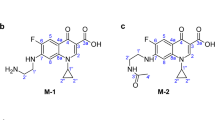Summary
The in vivo formation of the diazepam-like 1,4-benzodiazepine deschloronordiazepam from its assumed biogenetic precursors, 2-aminobenzophenone and glycine, by the mould strainPenicillium verrucosum var.verrucosum, is described. Deschloronordiazepam formation was established by GC/MSD analysis monitoring characteristic fragment patterns of the benzodiazepine moiety. The identification of deschloronordiazepam was confirmed by feeding experiments of D5-2-aminobenzophenone, as well as its brominated and chlorinated derivatives to the mould. The formation of the 1,4-benzodiazepine was observed to depend on various factors, e.g. the time of application of the precursors, duration of the incubation and kind of cultivation. The results represent the first actual de novo synthesis of such diazepam-like 1,4-benzodiazepines from plausible biosynthetic precursors in a living organism, in agreement with a biosynthetic concept recently established in our group. Such pharmacologically active 1,4-benzodiazepines had been detected in trace amounts in mammalian and plant tissues. Because of their unususal molecular framework, they had previously been considered not to fit into any conventional biosynthetic route.
Similar content being viewed by others
References
Angel A (1912) Isomeric change of halogen-substituted diacylanilides into acyclaminoketones. J Chem Soc 101: 515–519
Archer GA, Sternbach LH (1968) The chemistry of benzodiazepines. Chem Rev 68: 747–784
Bracken A, Pocker A, Raistrick H (1954) Cyclopenin, a nitrogen-containing metabolic product ofPenicillium cyclopium Westling. Biochem J 57: 587–593
Bringmann G (1992) A first biosynthetic proposal for the in vivo formation of naturally occurring diazepam-like 1,4-benzodiazepines. J Neural Transm [Gen Sect] 88: 77–82
Bringmann G, Mader T, Peters K, von Schnering HG (1993) Unexpected hydantoin formation in the attempted amidation with 2-aminobenzophenone of glyoxylic acid using dicyclohexylcarbodiimide. J Chem Soc Chem Commun 12: 1001–1002
Cunningham KG, Freeman GG (1953) The isolation and some chemical properties of viridicatin, a metabolic product ofPenicillium viridicatum Westling. Biochem J 53: 328–332
Domsch KH, Gams W (1970) Pilze aus Agrarböden, 1st edn. Fischer, Stuttgart, p 101
Klotz U (1990) Occurrence of natural diazepam in human brain. Biochem Pharmacol 39: 210–212
Luckner M, Mothes K (1963) Die Biosynthese von Viridicatin. Arch Pharm 296: 18–33
Medina JH, Pena C, Piva M, Paladini AC, de Robertis E (1988) Presence of benzodiazepine-like molecules in mammalian brain and milk. Biochem Biophys Res Commun 152: 534–539
Medina JH, Danelon JL, Wasowski G, de Stein ML, Paladini AC (1991) Production of benzodiazepine-like compounds in bovine rumen. Biochem Biophys Res Commun 181: 1048–1055
Overwil BH, Meyer HR (1973) Verfahren zur Herstellung von Benzodiazepin-Derivaten. DOS 2252378
Piva MA, Medina JH, de Blas AL, Pena C (1991) Formation of benzodiazepine-like molecules in rat brain. Biochem Biophys Res Commun 180: 972–981
Sangameswaran L, Fales HM, Friedrich P, De Blas AL (1986) Purification of a benzodiazepine from bovine brain and detection of benzodiazepine-like immunoreactivity in human brain. Proc Natl Acad Sci USA 83: 9236–9240
Scheifele HJ, De Tar DF (1952) 2-Aminobenzophenone. Org Synth 32: 8–13
Unseld E, Krishna DR, Fischer C, Klotz U (1989) Detection of diazepam and desmethyldiazepam in brain of different species and plants. Biochem Pharmacol 38: 2473–2478
Van Pee KH (1990) Halogenation reactions catalyzed by bacterial haloperoxidases. Kontakte (Darmstadt) 1: 41–47
Wildmann J (1988) Increase of natural benzodiazepines in wheat and potato during germination. Biochem Biophys Res Commun 157: 1436–1443
Wildmann J, Möhler H, Vetter W, Ranalder U, Schmidt K, Maurer R (1987) Diazepam andN-desmethyldiazepam are found in rat brain and adrenal and may be of plant origin. J Neural Transm 70: 383–398
Author information
Authors and Affiliations
Additional information
Naturally occurring diazepam-like benzodiazepines, part 4 for part 3, see: Bringmann et al. (1993)
Rights and permissions
About this article
Cite this article
Bringmann, G., Mader, T. In vivo formation of diazepam-like 1,4-benzodiazepines byPenicillium verrucosum var.verrucosum after administration of 2-aminobenzophenones and glycine. J. Neural Transmission 101, 169–181 (1995). https://doi.org/10.1007/BF01271554
Received:
Accepted:
Issue Date:
DOI: https://doi.org/10.1007/BF01271554




